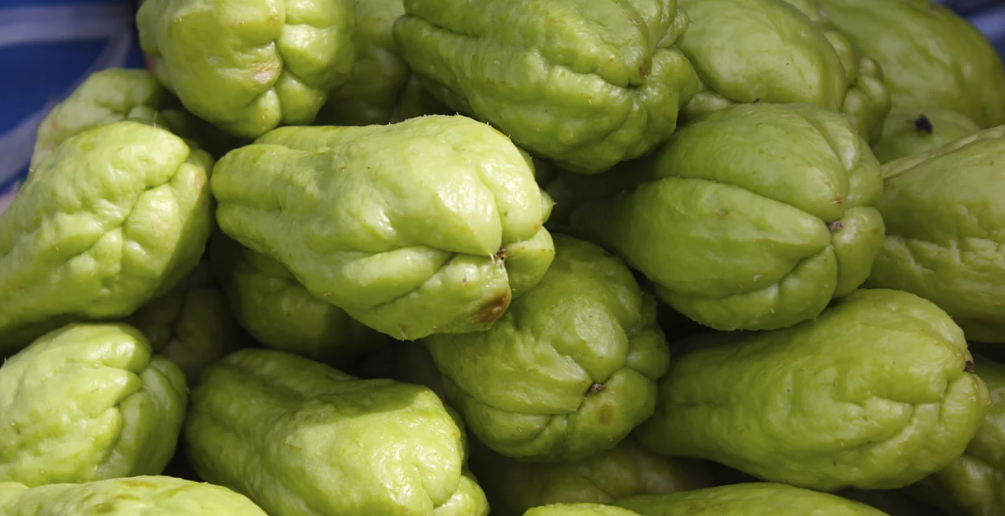High blood pressure, also known as hypertension, affects millions worldwide, increasing the risk of heart disease, stroke, and other chronic conditions.
While medication plays a crucial role in managing hypertension, dietary modifications can be equally powerful allies. Enter the humble chayote, a unique vegetable with a surprising secret weapon: its potential to lower blood pressure. Now you are wondering how to prepare chayote for high blood pressure.
Discover how chayote, a versatile veggie, can be incorporated into your diet to help manage high blood pressure. Learn about its benefits, preparation methods, and delicious recipes for a healthier, tastier life.
Chayote: A Nutritional Powerhouse for Blood Pressure Control
Chayote, also known as choko or mirliton, is a pear-shaped gourd native to Central America. This intriguing vegetable boasts a wealth of nutrients, including:
- Potassium: A key player in regulating blood pressure by counteracting the sodium-induced narrowing of blood vessels.
- Magnesium: Another mineral crucial for blood pressure control, promoting relaxation and reducing blood vessel tension.
- Fiber: Promotes satiety, aiding in weight management and reducing the risk of obesity, a major risk factor for hypertension.
- Vitamin C: A potent antioxidant that protects blood vessels from damage and inflammation.
Unlocking Chayote’s Culinary Versatility
The beauty of chayote lies in its versatility. Its mild, slightly sweet flavor readily adapts to various cooking methods, allowing you to incorporate it into your diet in countless ways. Here are some exciting preparation options:

- Raw and Refreshing: Enjoy chayote’s crisp texture by slicing it thinly and adding it to salads, alongside leafy greens, juicy tomatoes, and a tangy vinaigrette.
- Spiralized Sensation: Ditch the carb-laden noodles and embrace chayote noodles! Use a spiralizer to create zucchini-like strands, perfect for tossing with pesto, marinara sauce, or a light stir-fry.
- Roasted Delights: Toss chayote cubes with olive oil, herbs, and spices like paprika or cumin, then roast them until tender and slightly caramelized for a satisfying side dish.
- Soups and Stews: Add chayote chunks to your favorite soups and stews for a boost of flavor and nutrients. It readily absorbs the surrounding flavors, making it a versatile addition to broth-based dishes.
- Stuffed Surprises: Halve chayote, scoop out the flesh, and fill it with your favorite savory or sweet fillings. Try a lentil and vegetable mix for a hearty main course or a fruit and nut crumble for a guilt-free dessert.
- Pickled Perfection: Embrace the tangy world of pickling! Thinly sliced chayote makes a delightful addition to pickled vegetables, adding a unique crunch and subtle sweetness to the mix.
READ: Can You Take Garlic with Blood Pressure Medicine?
Harnessing Chayote’s Blood Pressure-Lowering Potential
While research is ongoing, studies suggest that incorporating chayote into your diet may offer several benefits for managing hypertension:
- Diuretic Effect: Chayote’s potassium content can act as a natural diuretic, helping the body eliminate excess sodium and reducing fluid buildup, which can contribute to high blood pressure.
- Improved Blood Flow: Certain compounds in chayote may help relax blood vessels and improve blood flow, further lowering pressure.
- Weight Management: Chayote’s low-calorie, high-fiber content promotes satiety and aids in weight management, a key factor in reducing hypertension risk.
How to Prepare Chayote for High Blood Pressure?
While chayote offers a promising dietary tool, remember it’s one piece of a larger puzzle. To effectively manage high blood pressure, a holistic approach is crucial:
- Maintain a healthy weight: Excess weight puts extra strain on your cardiovascular system, contributing to hypertension. Aim for a healthy weight range through a balanced diet and regular exercise.
- Reduce sodium intake: Limit your intake of processed foods and add salt, opting for natural herbs and spices to flavor your meals.
- Embrace regular exercise: Physical activity helps lower blood pressure and improve overall cardiovascular health. Aim for at least 150 minutes of moderate-intensity exercise per week.
- Manage stress: Chronic stress can exacerbate hypertension. Practice relaxation techniques like yoga or meditation to manage stress levels effectively.
- Consult your doctor: High blood pressure requires regular monitoring and medical guidance. Work closely with your doctor to determine the best treatment plan for you.
Delicious Chayote Recipes for Lowering Blood Pressure
Ready to incorporate chayote’s goodness into your blood pressure-lowering journey? Here are some delectable recipe ideas:

- Chayote Noodle Salad with Lemon Tahini Dressing: This light and refreshing salad features spiralized chayote noodles tossed with crunchy vegetables, herbs, and a creamy tahini dressing for a satisfying lunch.
- Spicy Chayote and Black Bean Soup: This hearty and flavorful soup combines chayote cubes with black beans, corn, tomatoes, and a touch of jalapeño for a warm and comforting meal that’s packed with potassium and fiber.
- Chayote and Quinoa Stuffed Peppers: Bell peppers become vibrant vessels for a nutritious and delicious filling of chayote, quinoa, chopped vegetables, and herbs. This dish is low in calories and high in protein and fiber, making it a perfect option for a satisfying and healthy dinner.
- Chayote and Mango Salsa: This vibrant salsa is a burst of flavor and freshness. Chopped chayote, mango, red onion, and cilantro combine with a touch of lime juice to create a perfect accompaniment for grilled fish, tacos, or even as a dip for crudités.
- Chayote and Coconut Curry: This aromatic curry features chayote chunks simmered in a creamy coconut milk sauce with turmeric, ginger, and garam masala. Serve it over brown rice or quinoa for a comforting, exotic meal that’s good for your heart.
- Chayote and Apple Crumble: Craving a sweet treat? This guilt-free crumble features a base of chayote and apples, topped with a crunchy oat and nut crumble. The natural sweetness of the chayote and apples makes it a satisfying dessert without the added sugar rush.
Beyond the Plate: Maximizing Chayote’s Potential
The benefits of chayote extend beyond culinary delights. Here are some additional ways to harness its power:
- Chayote Tea: Steep chayote leaves in hot water to create a naturally diuretic tea that can help lower blood pressure.

Image Credit: Tua Saude - Chayote Seed Flour: Ground chayote seeds can be used as a gluten-free alternative to wheat flour in baking, adding a unique nutty flavor and a boost of nutrients.
- Chayote Loofah: The fibrous interior of the chayote can be used as a natural loofah for gentle exfoliation.
Remember:
- While chayote offers promising benefits for managing blood pressure, it’s crucial to consult your doctor before making any significant dietary changes, especially if you have underlying medical conditions.
- Chayote is generally safe for most people, but some individuals may experience mild digestive discomfort due to its high fiber content. Start with smaller portions and gradually increase your intake as your body adjusts.
- Enjoy the journey of exploring the chayote’s versatility! Experiment with different flavors and cooking methods to discover your favorite ways to incorporate this unique vegetable into your diet for a healthier, tastier life.
Conclusion
High blood pressure, a silent menace affecting millions, often demands a multi-pronged approach to effective management. Alongside medication and lifestyle modifications, embracing dietary changes can play a powerful role.
Enter the humble chayote, a versatile vegetable with a surprising secret weapon: its potential to contribute to lowering blood pressure.
From its potassium-rich content to its blood vessel-relaxing compounds, chayote offers a natural advantage in the fight against hypertension.
Whether enjoyed raw, roasted, stuffed, or even brewed into tea, incorporating this unique vegetable into your diet presents a delicious and nutritious way to support your heart health.
Remember, chayote is not a silver bullet, but a valuable tool in your health arsenal. Embrace its culinary versatility, explore its diverse flavors, and experiment with incorporating it into your meals. Combine this with a healthy lifestyle and regular medical checkups for a comprehensive approach to managing high blood pressure.
Resources & References
- National Institutes of Health: https://www.nhlbi.nih.gov/health-topics/high-blood-pressure/health-professional-information
- American Heart Association: https://www.heart.org/en/health-topics/high-blood-pressure
- WebMD: https://www.webmd.com/diet/video/one-food-wonder-chayote-squash
- Healthline: https://www.healthline.com/nutrition/chayote-squash
- Medical News Today: https://health.usnews.com/health-news/blogs/eat-run/articles/vegetables-you-need-to-know
By embracing chayote’s potential and incorporating it into your diet alongside a healthy lifestyle, you can take a delicious step towards conquering high blood pressure and living a healthier, happier life. So, grab a chayote, unleash your culinary creativity, and embark on a journey of wellness, one flavorful bite at a time!
FAQs About Chayote for High Blood Pressure
How much chayote should I eat for blood pressure control?
While exact amounts haven’t been definitively established, most studies suggest including around 1-2 servings of chayote per day in your diet for potential blood pressure-lowering benefits. One serving is roughly equal to one cup of chopped chayote. Remember, moderation is key. Start with smaller portions and gradually increase as tolerated.
Are there any side effects of eating chayote?
Chayote is generally safe for most people, but some may experience mild digestive discomfort due to its high fiber content. Start with smaller portions and increase intake gradually. If you have any underlying medical conditions, consult your doctor before incorporating chayote into your diet.
Can I eat chayote raw for blood pressure benefits?
Absolutely! Chayote’s mild, slightly sweet flavor makes it perfect for enjoying raw in salads, alongside leafy greens and a tangy vinaigrette. This preserves its vitamin C content and offers a refreshing way to incorporate it into your diet.
Does chayote taste like zucchini?
While both share a similar texture and green color, chayote has a milder and slightly sweeter flavor compared to zucchini. It readily absorbs surrounding flavors, making it versatile for different cooking methods.
What are some good alternative recipes for using chayote besides the ones mentioned?
The possibilities are endless! Try chayote fritters for a crispy snack, use it in stir-fries for a unique crunch, or blend them into smoothies for a creamy and nutritious boost. Chayote’s neutral flavor shines when paired with herbs and spices like paprika, cumin, or cilantro. Get creative and explore your culinary preferences!
Where can I find a chayote?
Chayote’s availability can vary depending on your location. Check your local supermarkets and farmers’ markets, especially in areas with Hispanic communities. Online retailers may also offer chayote for purchase. If you’re struggling to find it, ask your local produce manager for recommendations or consider substitutes like zucchini or summer squash.



